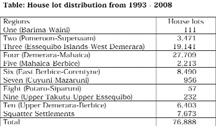– ministry eying speedier distribution
The Ministry of Housing has begun the move to a more organized and project-oriented system which will result in shortened transaction time for house lot applicants, and under this new dispensation no applicant, as long as he/she does not already own property, will be refused.
According to Housing Minister Irfaan Ali, the aim is to ensure that every person who applies for a house lot is interviewed in the shortest possible time and would then just have to await notification of the allocation.
During an exclusive interview with Stabroek News last week, Ali said that under an initiative he called “Operation Consolidate” there will be no “running up and down” by applicants. Instead, they will have the satisfaction that the necessary procedures are completed and allocation is ensured.

As part of the initiative too, Ali said, the ministry is working to complete all field audits as well as repossessions. The information gathered, he said, would be used to streamline the system.
This new system is to come on board shortly and will last for a period of three months. “The whole ministry is operating under various initiatives to move to a more projectised environment and not the normal run of the mill operation,” he said.
It has been 17 years since the PPP, under the leadership of late president Cheddi Jagan embarked on a massive housing drive. Quoting statistics, Ali said that from 1993 to the end of 2008, 76,888 house lots have been allocated countrywide. Regions Three (Essequibo Islands-West Demerara), Four (Demerara-Mahaica), Six (East Berbice-Corentyne) and Ten (Upper Demerara-Berbice) have always had the highest number of allocations.
(Insert Table.doc here)
House lots are allocated in the low or middle-income categories. Ali said that as a general rule, in all of the housing development taking place, 80% of lots must belong to low-income earners. These developments, he added, are highly subsidized by government.
“The subsidy is more- that is 475% of the cost of the lot – it brings an equity value to the land. So you could now take this to the bank for a loan,” he said. The remaining 20% of infrastructure development is dedicated to the moderate to middle-income category.
The Central Housing and Planning Authority (CHPA) located in the capital city, is the highest authority in house lot allocation. However, in regions outside Georgetown, Ali said, there are established regional housing committees that would assist in the receiving and processing of applications and the interviewing of prospective lot owners. He said records are made of these transactions and minutes of these meetings are recorded. He noted that this allowed for involvement at the regional level.
“And for transparency, our system here is audited and from time to time we publish names of allotees for public verification. We do as much public allocation as possible so persons in the community could see who the lot was given to,” he said. In these exercises, too, he said, feedback is received which tends to indicate when there are persons trying to beat the system.
Changed criteria
When the housing programme was first introduced, Ali said, the demand was extremely high for land but the criteria were stringent. As such ownership of a house lot was limited to married couples with children.
Today, he said, this has been altered and now persons without children and professional groups are included. He noted too that there are special schemes that promote partnerships, as well as those for nurses and teachers, all of whom would have to qualify based on income and other criteria.

The ministry also advises that persons in common-law relationships apply jointly to protect both parties. There is also a scoring mechanism; persons have to attain 546 to 616 points to qualify. The low-income lots are generally for persons who earn less than $60,000 each month and have children under the age of 21 years.
Expenditure
According to Ali, from 1993 to date, government has expended more than $15 billion in housing development. Added to this, the more than $4.5 billion collected by the CHPA has been reinvested in the programme. However, he said that this could not help the ministry meet all its targets.
“The resources collected could by no means satisfy the demand for the development of all these schemes. Basically every single cent we collect is reinvested in new areas,” he said.
On the issue of infrastructure, Ali told Stabroek News he felt it would be “foolish” for the government to put top level infrastructure in a scheme which has no occupancy, adding that as persons move in they could do much destruction.
He explained that the minimum or what he termed “primary infrastructure” included the main access roads being paved with asphalted concrete and internal road networks at loam sand level; a water distribution network and earthen drainage; and electricity, which is the latest addition to the “primary infrastructure” list.
The minster emphasized that incremental paving of the roads and other top level infrastructure increased simultaneously with occupancy rates.
All money collected by the CHPA, Ali said, is accounted for in financial reports which are presented every year at the ministry’s statutory board meeting and also to the National Assembly. He said the ministry is now in the process of preparing the financial statements for auditing purposes and added that its 2007 financial statement is currently with the Auditor General.
Occupancy
There is a 75% overall occupancy rate of house lots, Ali reported. However, he said the ministry was in the process of conducting field audits. He said the ministry has strengthened its internal audit department to include a section which will deal exclusively with field audits.
This department is responsible for verifying whether any illegal sales of house lots have taken place. When such cases are detected, both parties are called in, the land is repossessed and the matter handed over to the police for further action. While he could not give an exact number as to how many of these have taken place over the years, Ali said that over the last few months there has been an increase in construction in all of the housing schemes.
“So I think this is as a result of the one-stop-shop exercise, and our stern position on the imposition of the repossessing policy,” he emphasized.
Meanwhile, persons de-sirous of knowing whether house lots are available and in which areas, would first of all have to apply. Ali told Stabroek News that notification is usually available, adding that at the time of the interview persons can identify a priority area and the ministry would indicate whether there have been housing developments in the applicant’s area of choice. If not, the ministry could try to allocate a lot close to the applicant’s choice area. The applicant then has a choice to accept it, or to wait until another area is being developed and allocation starts for that area. Ali said no person who applies for a plot of land is refused. Rather, he said, the ministry qualifies that person for a house lot.
“Once they meet criteria and do not already own property then they are likely to be successful,” he said.
If a person has received a letter of repossession from the ministry either for arrears or an inability to start construction on the land, there is an appeal system they could tap into.
Ali said they could appeal in writing to him and the board. With regard to the appeals, he said several of them have been successful. For this year alone, he said, 400 repossession notices were issued and about 100 persons appealed and more than 75% of them were granted extensions either to complete payments or start construction.
“Our intention is not to take back land,” he emphasized.
Clearing the
backlog
Over the years the application process for a house lot had taken as long as three years. According to Ali the emphasis now is on clearing the backlog. “When we do this we take the services close to the people, reduce the loss of doing business, reduce transaction time and cost and create increased efficiency.”
He said that once applicants who go to drop in applications had all their documentation ready, they could be interviewed and just await the next step.
Many persons have been awarded house lots under this new initiative, forming a large part of the more than 1,500 lots which have been distributed this year alone.
He said the initiative has been seen as a very proactive approach to dealing with the backlog, thereby ensuring community participation in the process and allowing for greater transparency in the allocation.
In terms of assuring eligibility on the ground and monitoring the transparency of the one stop shop exercise, the ministry depends on documentation in the form of affidavits.
However the ministry has come across some problems in this regard since according to Ali, misinformation is facilitated by some Justices of the Peace and Commissioners of Oaths to Affidavits.
“We do verification with our database and we caught persons who applied, for instance, and then had their husbands apply, but we have screened those out,” he said.
No new squatter settlements
While work is being done to afford all house lot applicants a piece of land to call their own, the ministry is also planning to implement an aggressive and continuous programme to target the development of squatter settlements.
According to Ali, as at January 2009 there were approximately 218 of these around the country. He said the ministry is in the process of regularizing 164 of them “but we will not allow new ones to develop.
“We will have an aggressive plan to stop them from developing and this will call for much collaboration,” he emphasized. To this end he pointed to the Mayor and City Council, the various Neighbourhood Democratic Councils and the ministries of Agriculture and Public Works which will have to play a part in the effort.
However, he said there are about 30 squatter settlements that can never be regularised for a number of reasons. Many of them did not qualify following a condition survey. As he pointed out, there were no criteria for squatter settlements to be regularised and the ministry has to ensure that the land is in a safe location; not vulnerable to any natural disaster and that there is the relevant space for development of infrastructure and provision of services.
It also should not pose health and environmental risks to the community and the land must be vested or transferable to the Government of Guyana.
He cited an area at Vreed-en-Hoop, West Coast Demerara, called ‘Plastic City’, which residents want regularized. Ali said persons there are basically living “in the sea” and government could not afford to have its citizens exposed to such risks.
“Nature itself will force them to move so we can’t regularize that area,” he explained.




